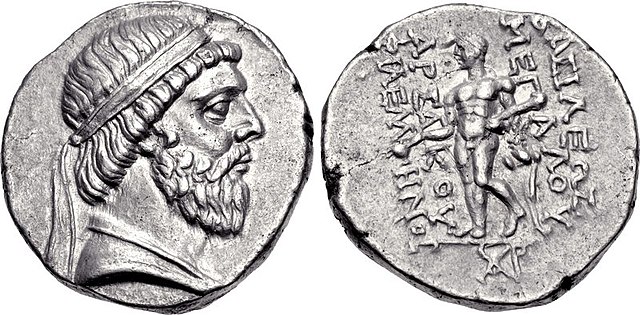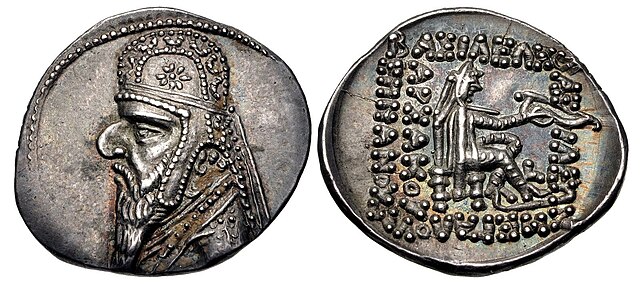The Parthian Empire, also known as the Arsacid Empire, was a major Iranian political and cultural power centered in ancient Iran from 247 BC to 224 AD. Its latter name comes from its founder, Arsaces I, who led the Parni tribe in conquering the region of Parthia in Iran's northeast, then a satrapy (province) under Andragoras, who was rebelling against the Seleucid Empire. Mithridates I greatly expanded the empire by seizing Media and Mesopotamia from the Seleucids. At its height, the Parthian Empire stretched from the northern reaches of the Euphrates, in what is now central-eastern Turkey, to present-day Afghanistan and western Pakistan. The empire, located on the Silk Road trade route between the Roman Empire in the Mediterranean Basin and the Han dynasty of China, became a center of trade and commerce.
The silver drachma of Arsaces I (r. c. 247 – 211 BC) with the Greek language inscription ΑΡΣΑΚΟΥ "of Arsaces"
Parthia, shaded yellow, alongside the Seleucid Empire (blue) and the Roman Republic (purple) around 200 BC
Drachma of Mithridates I, showing him wearing a beard and a royal diadem on his head. Reverse side: Heracles/Verethragna, holding a club in his left hand and a cup in his right hand; Greek inscription reading ΒΑΣΙΛΕΩΣ ΜΕΓΑΛΟΥ ΑΡΣΑΚΟΥ ΦΙΛΕΛΛΗΝΟΣ "of the Great King Arsaces the Philhellene"
Drachma of Mithridates II (r. c. 124–91 BC). Reverse side: seated archer carrying a bow; inscription reading "of the King of Kings Arsaces the Renowned/Manifest Philhellene."
The history of Iran is intertwined with that of Greater Iran, a sociocultural region spanning the area between Anatolia in the west and the Indus River and Syr Darya in the east, and between the Caucasus and Eurasian Steppe in the north and the Persian Gulf and the Gulf of Oman in the south. Central to this area is the modern-day country of Iran, which covers the bulk of the Iranian plateau.
Cylinder with a ritual scene, early 2nd millennium BC, Geoy Tepe, Iran
Chogha Zanbil is one of the few extant ziggurats outside of Mesopotamia and is considered to be the best preserved example in the world.
A gold cup at the National Museum of Iran, dating from the first half of 1st millennium BC
The tomb of Cyrus the Great








